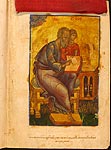Radoslav Gospel. Tetraevangelion.
1428-1429. Serbian version. Artist: Radoslav. Scribe: - "Inok from Dalsa" [Celibate Priest Feodor]. Fragment
F (377/378 ı 250/260). IV + 12 leaves.
Paper. Ink, cinnabar, colours, gold.
It is written in a semi-uncial hand.
The illumination of the manuscript includes 4 portraits of the Evangelists: on folio 1r is a picture of Matthew, on folio 2r is Mark, on folio 3r is Luke, on folio 4r is John. Folio 5r bears the head-piece in colours on a gold background and a splendid colourful initial, executed with use of gold. The heading, one small capital latter in the text and crosses (instead of punctuation dots) are written in gold. Folio 6r has the initial letter in cinnabar on it.
Folios 6-12 contains the scribe's notes. This is a original literary work, based on the autobiographical story. "Inok from Dalsa" did not leave his name. The narration of "Inok from Dalsa" represents an evidence of the creation of book, the working methods of medieval scribes and their lives. It is also a very interesting document that records historical events in Serbia during the third decade of the 15th century.
The Radoslav Gospel is one of the best-known memorials of Old Serbian manuscript heritage. The decoration of the manuscript clearly shows traditions of the Byzantine art from Palaeologos period of the Byzantine Empire. Portraits of the Evangelists are painted in colours on a gold background. The traditional symbols of the Evangelists, as well as a representation of Sophia-Wisdom with a halo of two intersected rhombuses, are depicted along with them. Sophia personifies wisdom. This iconography is not unique, personifications of wisdom are well-known in Greek and South Slavic, especially Serbian, iconography. In each of four portraits, the Evangelist and Sophia-Wisdom touch heads, that symbolizes their entire spiritual unity and the direct transfer of the divine inspiration, descending upon the Evangelist. The manuscript was brought back by Archbishop Porfiry Uspensky from the Saint Paul's Monastery on Mount Athos.
In 1883 the manuscript came into the Imperial Public Library along with the material gathered by Archbishop Porfiry Uspensky.
Shelfmark: –Õ¡. F.I.591.





